

The Bloom's Taxonomy Periodic Table of Activities for Inspired Learning. 50 Resources For Teaching With Bloom's Taxonomy - Simple suggestions for applying the taxonomy to kindergarten-level children.
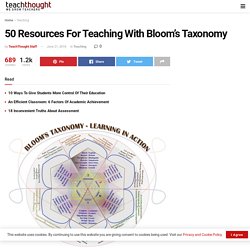
Lesson Planet: This source gives the goods on creating complete lesson plans using Bloom’s Taxonomy. Prezi: Enjoy this stylish Prezi presentation on Bloom’s Taxonomy. Bloom's Digital Taxonomy for The Web. 249 Bloom's Taxonomy Verbs For Critical Thinking. 249 Bloom’s Taxonomy Verbs For Critical Thinking by TeachThought Staff Bloom’s Taxonomy’s verbs–also know as power verbs or thinking verbs–are extraordinarily powerful instructional planning tools.
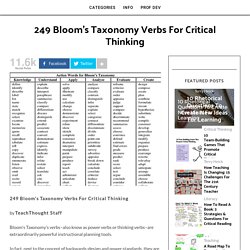
In fact, next to the concept of backwards-design and power standards, they are likely the most useful tool a teacher-as-learning-designer has access to. Why? They can be used for curriculum mapping, assessment design, lesson planning, personalizing and differentiating learning, and almost any other “thing” a teacher–or student–has to do. For example, if a standard asks students to infer and demonstrate an author’s position using evidence from the text, there’s a lot built into that kind of task. Though the chart below reads left to right, it’s ideal to imagine it as a kind of incline, with Knowledge at the bottom, and Create at the top. 20 Ways To Use PowerPoint With Bloom’s Taxonomy. 8 Wonderful Blooms Taxonomy Posters for Teachers. A New Wonderful Wheel on SAMR and Bloom's Digital Taxonomy. The buzz that the Modern Taxonomy Wheel generated over the last couple of weeks has not yet died out and now we have a new updated wheel from the same guy Allan Carrington.
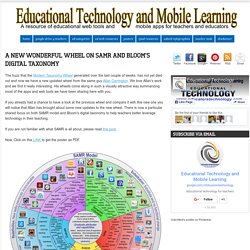
We love Allan's work and we find it really interesting. His wheels come along in such a visually attractive way summarizing most of the apps and web tools we have been sharing here with you. If you already had a chance to have a look at the previous wheel and compare it with this new one you will notice that Allan has brought about some new updates to the new wheel. There is now a particular shared focus on both SAMR model and Bloom's digital taxonomy to help teachers better leverage technology in their teaching. New: Bloom's Taxonomy Planning Kit for Teachers. March 28, 2014 Somebody shared with me this wonderful Bloom's Taxonomy Planning Kit for Teachers and want you to have a look as well.
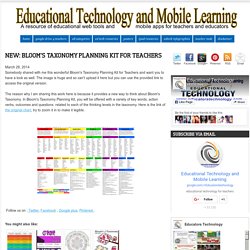
The image is huge and so can't upload it here but you can use the provided link to access the original version. The reason why I am sharing this work here is because it provides a new way to think about Bloom's Taxonomy. In Bloom's Taxonomy Planning Kit, you will be offered with a variety of key words, action verbs, outcomes and questions related to each of the thinking levels in the taxonomy. Here is the link of the original chart, try to zoom it in to make it legible. A New Fantastic Bloom's Taxonomy Wheel for iPad Apps. March 21, 2014 Today while I was browsing through my Twitter feeds I came across this fabulous Bloom's Taxonomy wheel of apps shared by Anthony.

If you still recall, some previous versions of this wheel have already been featured here in Bloom's Taxonomy for Teachers section . As you can see, the wheel outlines a wide variety of verbs and activities related to each thinking level of Blooms taxonomy coupled with iPad apps that go with it. These apps are supposed to help teachers and students better cultivate these different thinking levels in their use of iPad apps. And because the the visual is not hyperlinked, I went ahead and provided the links for each of these apps in the lists below. Enjoy. Bloom's Taxonomy Verbs - Free Classroom Chart. 4 Strategies For Teaching With Bloom's Taxonomy. 4 Strategies For Teaching With Bloom’s Taxonomy by TeachThought Staff Bloom’s Taxonomy can be a powerful tool to transform teaching and learning.

By design, it focuses attention away from content and instruction, and instead emphasizes the “cognitive events” in the mind of a child. And this is no small change. For decades, education reform has been focused on curriculum, assessment, instruction, and more recently standards, and data, with these efforts only bleeding over into how students think briefly, and by chance. This stands in contrast to the characteristics of the early 21st century, which include persistent connectivity, dynamic media forms, information-rich (digital and non-digital) environments, and an emphasis on visibility for pretty much everything.
14 Bloom's Taxonomy Posters For Teachers. 14 Brilliant Bloom’s Taxonomy Posters For Teachers by TeachThought Staff Bloom’s Taxonomy is a useful tool for assessment design, but using it only for that function is like using a race car to go to the grocery–a huge waste of potential.
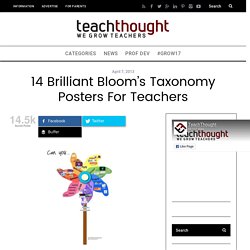
In an upcoming post we’re going to look at better use of Bloom’s taxonomy in the classroom, but during research for that post it became interesting how many variations there are of the original work. While a handful of the charts below only show aesthetic changes compared to others, most are concept maps of sorts–with graphic design that signifies extended function (power verbs), detail (clear explanations), or features of some sort (Bloom’s Taxonomy tasks by level). The follow simple, student-centered Bloom’s graphics were created by helloliteracy! A 3 Dimensional Model Of Bloom's Taxonomy - A 3-Dimensional Model Of Bloom’s Taxonomy by TeachThought Staff Well, technically it’s a 2-dimensional representation of a 3-dimensional model, but being limited as we are in 2016 to 2D screens, it is what it is.
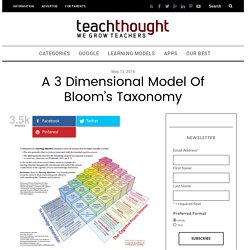
(Soon you’ll be able to 3D print what you see–download the plans and print it. Or play with it in virtual reality. Eventually a hologram you can manipulate digitally–pass around the room like a tennis ball, then fling it into the ether….) Rex Heer at Iowa State University, who created the graphic, explains: Among other modifications, Anderson and Krathwohl’s (2001) revision of the original Bloom’s taxonomy (Bloom & Krathwohl, 1956) redefines the cognitive domain as the intersection of the Cognitive Process Dimension and the Knowledge Dimension. This document offers a three-dimensional representation of the revised taxonomy of the cognitive domain. Take Action: Verbs That Define Bloom’s Taxonomy. Bloom’s Taxonomy gets an active makeover in this infographic, which provides a way to think about how the actions involved in a class assignment might be categorized in the schema.
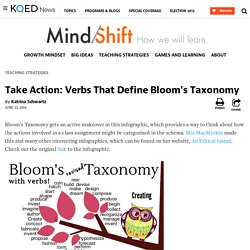
Mia MacMeekin made this and many other interesting infographics, which can be found on her website, An Ethical Island. Check out the original link to the infographic. Katrina Schwartz. Flip This: Bloom’s Taxonomy Should Start with Creating. Chris Davis, Powerful Learning Practice LLC By Shelley Wright I think the revised Bloom’s Taxonomy is wrong.
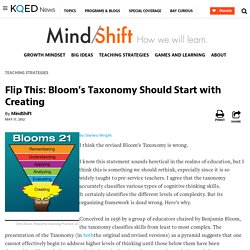
I know this statement sounds heretical in the realms of education, but I think this is something we should rethink, especially since it is so widely taught to pre-service teachers. I agree that the taxonomy accurately classifies various types of cognitive thinking skills. It certainly identifies the different levels of complexity. Conceived in 1956 by a group of educators chaired by Benjamin Bloom, the taxonomy classifies skills from least to most complex.
Many teachers in many classrooms spend the majority of their time in the basement of the taxonomy, never really addressing or developing the higher order thinking skills that kids need to develop. The pyramid creates the impression that there is a scarcity of creativity — only those who can traverse the bottom levels and reach the summit can be creative. New Bloom's Taxonomy Sheet with Over 80 Web Tools to Try Out. Dok_blooms_comparison.pdf. Bloom's 'Digital' Taxonomy - Printable Reference Table. Bloom's taxonomy. Bloom's wheel, according to the Bloom's verbs and matching assessment types. The verbs are intended to be feasible and measurable. Flip This: Bloom’s Taxonomy Should Start with Creating. Teaching Strategies Chris Davis, Powerful Learning Practice LLC By Shelley Wright I think the revised Bloom’s Taxonomy is wrong.
I know this statement sounds heretical in the realms of education, but I think this is something we should rethink, especially since it is so widely taught to pre-service teachers. I agree that the taxonomy accurately classifies various types of cognitive thinking skills. Conceived in 1956 by a group of educators chaired by Benjamin Bloom, the taxonomy classifies skills from least to most complex. Many teachers in many classrooms spend the majority of their time in the basement of the taxonomy, never really addressing or developing the higher order thinking skills that kids need to develop. Rather than starting with knowledge, we start with creating, and eventually discern the knowledge that we need from it.
The New Bloom’s. It’s difficult to think about doing creative, authentic projects with students when the school is consumed with test prep fever and the state tests are just a week away. Testing has, indeed, had a tremendous impact on curriculum and instruction in our schools. While tests give us benchmark data on where students are with knowledge and skill development, they often fall short of helping students develop the higher level thinking skills that 21st century students need for a technological workplace. Creative projects, on the other hand, almost always engage students in analytical and evaluative thinking. They are not about giving the right answer; rather, they are all about extending information to find solutions or develop new ideas. Rubrics - Bloom's Digital Taxonomy. 20 Great Rubrics for Integrating Bloom's Digital Taxonomy in Your Teaching.
June 15, 2014 I have always been inspired by the great work of Andrew Church. K-5 iPad Apps According to Bloom's Taxonomy. Bloom's Taxonomy of Learning Domains. Note: This site is moving to KnowledgeJump.com. Please reset your bookmark. Bloom's Taxonomy was created in 1956 under the leadership of educational psychologist Dr Benjamin Bloom in order to promote higher forms of thinking in education, such as analyzing and evaluating concepts, processes, procedures, and principles, rather than just remembering facts (rote learning). It is most often used when designing educational, training, and learning processes. Bloom's Taxonomy Resources. Using Instagram, Bloom’s Taxonomy & Student Interest As A Fun Part Of A Semester Final.
I’ve previously posted about some elements in my upcoming finals (see My Best Posts On Writing Instruction and scroll down near the bottom). Another element I’m trying out this year is having students in all my classes create Instagrams (see other ways I’ve used Instagram and Vine in my classes at The Best Resources For Learning To Use The Video Apps “Vine” & Instagram). K-5 iPad Apps According to Bloom's Taxonomy. K-5 iPad Apps According to Bloom's Taxonomy. 84 (And Counting) Bloom's Taxonomy Tools Worth Trying. BLOOM'S TAXONOMY'S MODEL QUESTIONS AND KEY WORDS.
Blooms%20Taxonomy%20questions. Levels of Questions in Bloom's Taxonomy: Teaching Methodoly Advice (Grades K. Page 1 of 2 The goal of classroom questioning is not to determine whether students have learned something (as would be the case in tests, quizzes, and exams), but rather to guide students to help them learn necessary information and material. Questions should be used to teach students rather than to just test students! Teachers frequently spend a great deal of classroom time testing students through questions. In fact, observations of teachers at all levels of education reveal that most spend more than 90 percent of their instructional time testing students (through questioning).
And most of the questions teachers ask are typically factual questions that rely on short-term memory. Jabberwocky Taxonomy is an orderly classification of items according to a systematic relationship (low to high, small to big, simple to complex). Although questions are widely used and serve many functions, teachers tend to overuse factual questions such as “What is the capital of California?” Fire Alarm Knowledge. 05-2Bloom-16-17+Stems+for+Instruction. BloomQuestions_000.pdf. BloomsTaxonomyQuestionStems.pdf. Bloom's taxonomy of learning domains - bloom's learning model, for teaching, lesson plans, training cousres design planning and evaluation.
Writing Objectives Using Bloom's Taxonomy. Bloom's Taxonomy. Mary Forehand The University of Georgia Introduction One of the basic questions facing educators has always been "Where do we begin in seeking to improve human thinking? " (Houghton, 2004). Fortunately we do not have to begin from scratch in searching for answers to this complicated question. The Communities Resolving Our Problems (C.R.O.P.) recommends, "One place to begin is in defining the nature of thinking.
Bloom’s Taxonomy. By Patricia Armstrong, Assistant Director, Center for Teaching. Blooms Taxonomy Action Verbs. Bloom's taxonomy. Bloom's Taxonomy of Learning Domains. Resources for Bloom's Taxonomy. 44 Prompts Merging Reflective Thinking With Bloom's Taxonomy. How do Web 2.0 Tools fit into Bloom's Taxonomy?